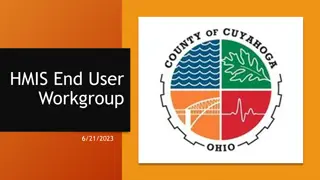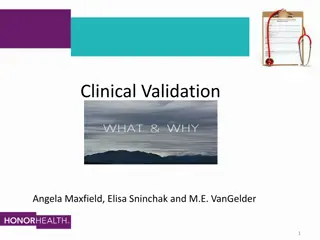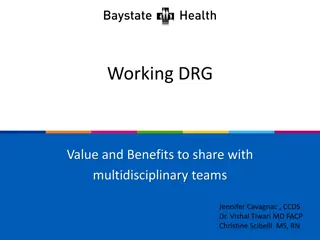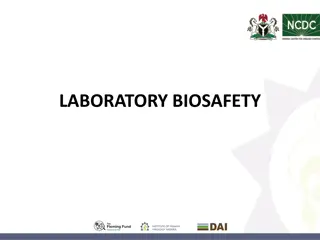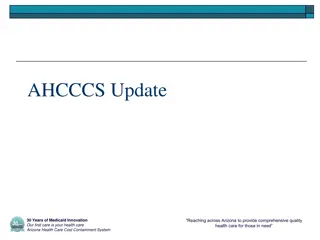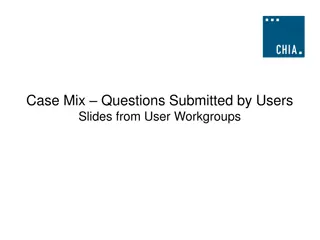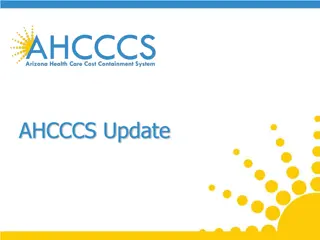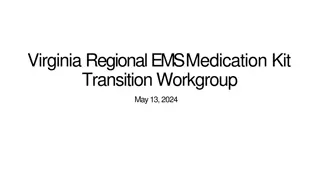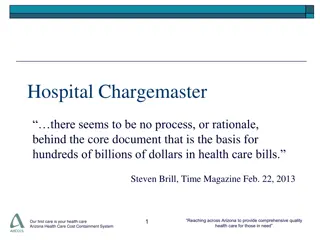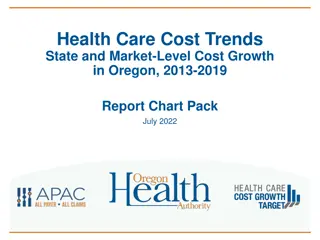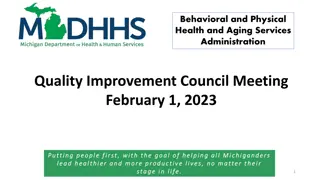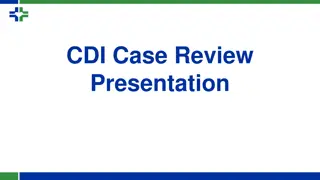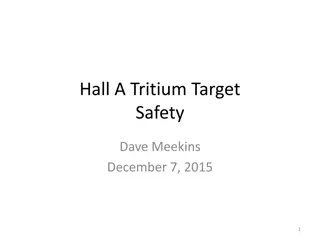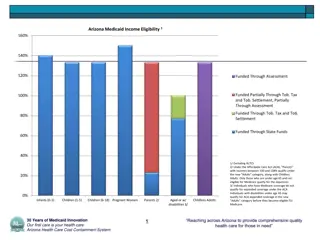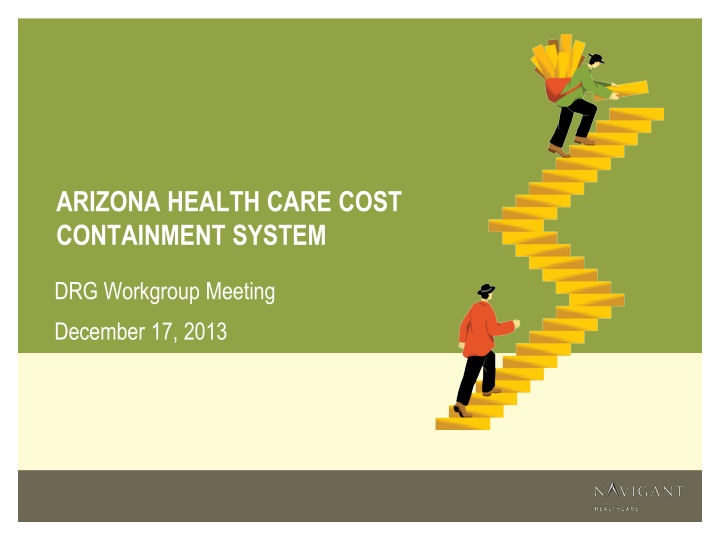
ARIZONA HEALTH CARE COST CONTAINMENT SYSTEM DRG Workgroup Meeting
In the Arizona Health Care Cost Containment System DRG workgroup meeting on December 17, 2013, updates were provided on the DRG model, hemophilia blood clotting factors, documentation, coding improvements, and future steps. The DRG model was adjusted with various changes since the previous version, focusing on fee-for-service claims, behavioral health plan cases, and hospital transfers. Pricing changes, provider adjustments, and specific payment factors were also covered in detail.
Download Presentation

Please find below an Image/Link to download the presentation.
The content on the website is provided AS IS for your information and personal use only. It may not be sold, licensed, or shared on other websites without obtaining consent from the author. If you encounter any issues during the download, it is possible that the publisher has removed the file from their server.
You are allowed to download the files provided on this website for personal or commercial use, subject to the condition that they are used lawfully. All files are the property of their respective owners.
The content on the website is provided AS IS for your information and personal use only. It may not be sold, licensed, or shared on other websites without obtaining consent from the author.
E N D
Presentation Transcript
ARIZONA HEALTH CARE COST CONTAINMENT SYSTEM DRG Workgroup Meeting December 17, 2013
TABLE OF CONTENTS Section 1 Model Update Section 2 Hemophilia blood clotting factors Section 3 Documentation and Coding Improvement Section 4 Next Steps Page 2
MODEL UPDATE Updated DRG model claim/encounter changes DRG model updated using FFY 2011 claims and encounter data, with the following adjustments since the November model version: FFY 2011 AIHP/FES fee-for-service claims added (IHS/638 providers still excluded) DHS Behavioral Health Plan (ID #079999) cases removed Licensed Short Term Specialty Hospitals removed in lieu of excluding non- contract providers (to be paid DRGs using different base rate) Chandler Regional pediatric cases moved to PCH Page 4
MODEL UPDATE Updated DRG model pricing changes The following DRG model payment factors were updated: Version 31 APR-DRGs and 3M national weights, without case mix adjustment FFY 2014 Medicare wage indices Transfer policy narrowed to transfers to another acute care hospital (discharge status codes of 02, 05, and 66) DRG base rates and policy adjuster factors modified to achieve model targets: Aggregate budget neutrality Statewide average pay-to-cost ratio for newborn/OB/pediatric services Current payment levels for psych/rehab Page 5
MODEL UPDATE Updated DRG model provider adjustments High Medicaid Volume criteria based on FFY 2011 model data and FYE 2011 Medicare cost report data Thresholds equal to 400% of provider simple average modeled Medicaid days and 30% MIUR Four providers met criteria; only one provider required a hold harmless adjustment (other three providers had a projected gain) Non-CAH rural adjustment: Non-CAH rural provider group (excluding high outlier providers) had an aggregate projected gain thus no hold harmless adjustment needed Page 6
HEMOPHILIA BLOOD CLOTTING FACTORS
HEMOPHILIA BLOOD CLOTTING FACTORS Model data Currently MCO plans are not required to retain HCPCS codes for all detail lines and AHCCCS does not have HCPCS code edits in MMIS Drug related J-codes often not included in the model data Blood clotting J-codes found on 52 detail lines from 4 providers AHCCCS collected FFY 2011 hemophilia blood clotting factor data from 5 providers 136 claim lines for $25.7 million in charges Payments under Medicare would equal approximately $2.0 million based on reported units Many cases did not have a hemophilia-related diagnosis code in the claim/encounter Page 8
DOCUMENTATION AND CODING IMPROVEMENT
DOCUMENTATION AND CODING IMPROVEMENT Proposed Approach Up-front 3 percent adjustment for expected Documentation and Coding Improvement (DCI) Will simulate a 3% casemix increase and determine an adjustment factor ( DCI Factor ) that would be necessary to maintain budget neutrality Claim allowed amounts (including the base DRG payment, outlier payment or transfer payment) will be reduced by the DCI factor Page 10
DOCUMENTATION AND CODING IMPROVEMENT Proposed Approach (continued) Periodically (and based on the availability and completeness of data) AHCCCS will measure actual increases or decreases in case mix attributable to DCI or Casemix Differential Based on measurement - AHCCCS intends to set the DCI Factor for the next year based on actual measured Casemix Differential If measured Casemix Differential is significantly different (more than 1 percentage point higher or lower) from the initial 3% assumption, further adjust the DCI Factor for the next year to prospectively correct for the previous year(s) Page 11
DOCUMENTATION AND CODING IMPROVEMENT Measuring Actual Casemix Differential Measure actual increases in acuity using Medicare s MS-DRG grouper and Medicare relative weights Assumes that measuring actual changes in casemix using MS-DRGs is a reasonable proxy for measuring actual change in acuity Assumes that hospitals have already responded to documentation and coding standards needed for payment under MS-DRGs Measure increases in acuity using APR-DRG grouper and relative weights using the same encounters The Casemix Differential is the difference between MS-DRG and APR-DRG casemix increases For example, for the same 12 month period, if MS-DRG casemix increases 1%, and APR-DRG casemix increases 4%, the Casemix Differential the amount attributable to DCI is 3 percentage points Page 12
DOCUMENTATION AND CODING IMPROVEMENT Example Scenario Year 3 Claims (DOS 10/1/16 9/30/17) Apply DCI Factor Modify Based on Year 2 Measurement Increase or Decrease Factor to Correct for Year 2 Over or Underpayment Year 2 Claims (DOS 10/1/15 9/30/16) Apply DCI Factor Modify Based on Year 1 Measurement Increase or Decrease Factor to Correct for Year 1 Over or Underpayment Year 1 Claims (DOS 10/1/14 9/30/15) Apply DCI Factor to Reflect 3% Reduction in CMI Allowable Corridor is from 2% to 4% 10/1/18 10/1/15 10/1/16 10/1/17 10/1/14 Measure CMI Differential Page 13
DOCUMENTATION AND CODING IMPROVEMENT Example 10/1/15 CMI differential measurement AHCCCS intends to measure CMI Differential using available Year 1 encounters. Set Year 2 DCI Factor to be equal to measured Year 1 CMI Differential Adjust Year 2 DCI Factor to correct for Year 1 overpayment or underpayment: If measured Year 1 CMI Differential is within allowable corridor, make no adjustment If measured Year 1 CMI Differential exceeds 4%, increase Year 2 DCI Factor by the difference between actual measured and 4% If measured Year 1 CMI Differential is less than 2%, decrease Year 2 DCI Factor by the difference between actual measured and 2% Page 14
DOCUMENTATION AND CODING IMPROVEMENT Example 10/1/16 CMI differential measurement AHCCCS intends to measure CMI Differential using available Year 2 encounters Alternatively use available encounters with DOS between 10/1/14 and date of measurement Set Year 3 DCI Factor to be equal to measured Year 2 CMI Differential Adjust Year 3 DCI Factor to correct for Year 2 overpayment or underpayment: If measured Year 2 CMI Differential is within allowable corridor, make no adjustment If measured Year 2 CMI Differential exceeds Year 2 DCI factor by more than 1 percentage point, increase Year 3 DCI Factor by the difference If measured Year 2 CMI Differential is more than 1 percentage point below the Year 2 DCI factor, decrease Year 2 DCI Factor by the difference Page 15
DOCUMENTATION AND CODING IMPROVEMENT Example 10/1/17 CMI differential measurement Rebase System Go Live new rates become effective Begin rebasing process 9-12 months prior to go live date Use most current 12 months of complete encounter data Based on results of previous analyses, determine need for additional DCI adjustments for 10/1/17, and going forward. Page 16
NEXT STEPS Finalize transition plan Finalize approach for documentation and coding improvement adjustments Publish rules for public review/comment Proposed approach for transplant services (not necessarily on the same timeline as APR-DRG implementation) Freestanding rehabilitation, psychiatric and LTAC providers to remain on current per diem rates Page 18

